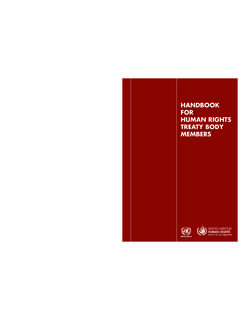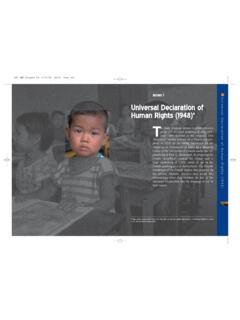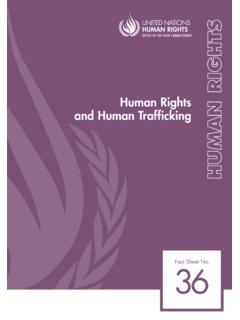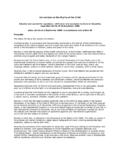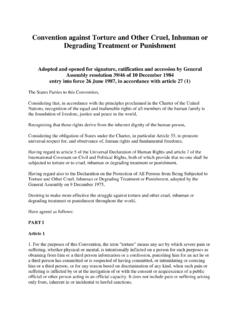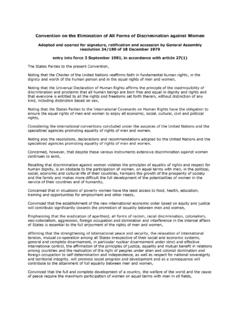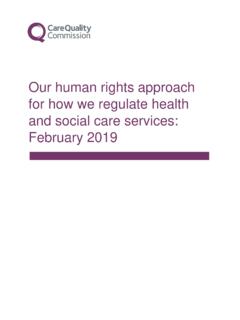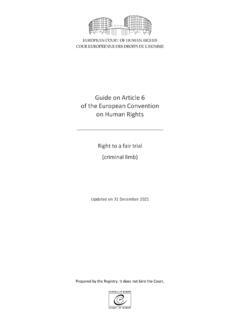Transcription of Fact Sheet No.2 (Rev.1), The International Bill of Human ...
1 Fact Sheet ( ), The International bill of Human RightsAll Human beings are born free and equal in dignity and rights . They are endowed with reasonand conscience and should act towards one another in a spirit of DECLARATION OF Human rights (art. 1),adopted by General Assembly resolution 217 A (III) of 10 December : Background Universal Declaration of Human rights International Covenants on Human rights Worldwide influence of the International bill of Human rights Annex: The International bill of Human rights - Universal Declaration of Human rights - International Covenant on Economic, Social and Cultural rights - International Covenant on Civil and Political rights - Optional Protocol to the International Covenant on Civil and Political rights - Second Optional Protocol to the International Covenant on Civil and Political rights , aiming at theabolition of the death penaltyBackgroundThe International bill of Human rights consists of the Universal Declaration of Human rights , theInternational Covenant on Economic, Social and Cultural rights , and the International Covenant on Civil andPolitical rights and its two Optional rights had already found expression in the Covenant of the League of Nations, which led, inter alia,to the creation of the International Labour Organisation.
2 At the 1945 San Francisco Conference, held to draftthe Charter of the United Nations, a proposal to embody a "Declaration on the Essential rights of Man" wasput forward but was not examined because it required more detailed consideration than was possible at thetime. The Charter clearly speaks of "promoting and encouraging respect for Human rights and forfundamental freedoms for all without distinction as to race, sex, language or religion" (Art. 1, para. 3). Theidea of promulgating an " International bill of rights " was also considered by many as basically implicit in Preparatory Commission of the United Nations, which met immediately after the closing session of theSan Francisco Conference, recommended that the Economic and Social Council should, at its first session,establish a commission for the promotion of Human rights as envisaged in Article 68 of the , the Council established the Commission on Human rights early in its first session, in 1946, the General Assembly considered a draft Declaration on Fundamental HumanRights and Freedoms and transmitted it to the Economic and Social Council "for reference to the Commissionon Human rights for consideration.
3 In its preparation of an International bill of rights " (resolution 43 (I)).The Commission, at its first session early in 1947, authorized its officers to formulate what it termed "apreliminary draft International bill of Human rights ". Later the work was taken over by a formal draftingcommittee, consisting of members of the Commission from eight States, selected with due regard forgeographical the Universal DeclarationIn the beginning, different views were expressed about the form the bill of rights should take. The DraftingCommittee decided to prepare two documents: one in the form of a declaration, which would set forthgeneral principles or standards of Human rights ; the other in the form of a convention, which would definespecific rights and their limitations. Accordingly, the Committee transmitted to the Commission on HumanRights draft articles of an International declaration and an International convention on Human rights .
4 At itssecond session, in December 1947, the Commission decided to apply the term " International bill of HumanRights" to the series of documents in preparation and established three working groups: one on thedeclaration, one on the convention (which it renamed "covenant") and one on implementation. TheCommission revised the draft declaration at its third session, in May/June 1948, taking into considerationcomments received from Governments. It did not have time, however, to consider the covenant or thequestion of implementation. The declaration was therefore submitted through the Economic and SocialCouncil to the General Assembly, meeting in its resolution 217 A (III) of 10 December 1948, the General Assembly adopted the Universal Declarationof Human rights as the first of these projected the International CovenantsOn the same day that it adopted the Universal Declaration, the General Assembly requested the Commissionon Human rights to prepare, as a matter of priority, a draft covenant on Human rights and draft measuresof implementation.
5 The Commission examined the text of the draft covenant in 1949 and the following yearit revised the first 18 articles, on the basis of comments received from Governments. In 1950, the GeneralAssembly declared that "the enjoyment of civic and political freedoms and of economic, social and culturalrights are interconnected and interdependent" (resolution 421 (V), sect. E). The Assembly thus decided toinclude in the covenant on Human rights economic, social and cultural rights and an explicit recognition ofthe equality of men and women in related rights , as set forth in the Charter. In 1951, the Commissiondrafted 14 articles on economic, social and cultural rights on the basis of proposals made by Governmentsand suggestions by specialized agencies. It also formulated 10 articles on measures for implementation ofthose rights under which States parties to the covenant would submit periodic reports.
6 After a long debateat its sixth session, in 1951/1952, the General Assembly requested the Commission "to draft two Covenantson Human rights , .. one to contain civil and political rights and the other to contain economic, social andcultural rights " (resolution 543 (VI), para. 1). The Assembly specified that the two covenants should containas many similar provisions as possible. It also decided to include an article providing that "all peoples shallhave the right of self-determination" (resolution 545 (VI)).The Commission completed preparation of the two drafts at its ninth and tenth sessions, in 1953 and General Assembly reviewed those texts at its ninth session, in 1954, and decided to give the drafts thewidest possible publicity in order that Governments might study them thoroughly and that public opinionmight express itself freely. It recommended that its Third Committee start an article-by-article discussion ofthe texts at its tenth session, in 1955.
7 Although the article-by-article discussion began as scheduled, it wasnot until 1966 that the preparation of the two covenants was International Covenant on Economic, Social and Cultural rights and the International Covenant on Civiland Political rights were adopted by the General Assembly by its resolution 2200 A (XXI) of 16 December1966. The first Optional Protocol to the International Covenant on Civil and Political rights , adopted by thesame resolution, provided International machinery for dealing with communications from individuals claimingto be victims of violations of any of the rights set forth in the Declaration of Human RightsThe Universal Declaration of Human rights was adopted and proclaimed by the General Assemblyas a common standard of achievement for all peoples and all nations, to the end that every individual andevery organ of society, keeping this Declaration constantly in mind, shall strive by teaching and education topromote respect for these rights and freedoms and by progressive measures, national and International , tosecure their universal and effective recognition and observance, both among.
8 The peoples of Member Statesthemselves and among the peoples of territories under their States voted in favour of the Declaration, none against, with eight abstentions. In a statementfollowing the voting, the President of the General Assembly pointed out that adoption of the Declaration was"a remarkable achievement, a step forward in the great evolutionary process. It was the first occasion onwhich the organized community of nations had made a Declaration of Human rights and fundamentalfreedoms. The instrument was backed by the authority of the body of opinion of the United Nations as awhole, and millions of people -men, women and children all over the world- would turn to it for help,guidance and Declaration consists of a preamble and 30 articles, setting forth the Human rights and fundamentalfreedoms to which all men and women, everywhere in the world, are entitled, without any 1, which lays down the philosophy on which the Declaration is based, reads:All Human beings are born free and equal in dignity and rights .
9 They are endowed with reason andconscience and should act towards one another in a spirit of article thus defines the basic assumptions of the Declaration: that the right to liberty and equality isman's birthright and cannot be alienated: and that, because man is a rational and moral being, he isdifferent from other creatures on earth and therefore entitled to certain rights and freedoms which othercreatures do not 2, which sets out the basic principle of equality and non discrimination as regards the enjoyment ofhuman rights and fundamental freedoms, forbids "distinction of any kind, such as race, colour, sex,language, religion, political or other opinion, national or social origin, property, birth or other status".Article 3, the first cornerstone of the Declaration, proclaims the right to life, liberty and security of person -aright essential to the enjoyment of all other rights .
10 This article introduces articles 4 to 21, in which other civiland political rights are set out, including: freedom from slavery and servitude; freedom from torture andcruel, inhuman or degrading treatment or punishment; the right to recognition everywhere as a personbefore the law; the right to an effective judicial remedy; freedom from arbitrary arrest, detention or exile;the right to a fair trial and public hearing by an independent and impartial tribunal; the right to be presumedinnocent until proved guilty; freedom from arbitrary interference with privacy, family, home orcorrespondence; freedom of movement and residence; the right of asylum; the right to a nationality; theright to marry and to found a family; the right to own property; freedom of thought, conscience andreligion; freedom of opinion and expression; the right to peaceful assembly and association; and the right totake part in the government of one's country and to equal access to public service in one's 22, the second cornerstone of the Declaration, introduces articles 23 to 27, in which economic, socialand cultural rights -the rights to which everyone is entitled "as a member of society" -are set out.

